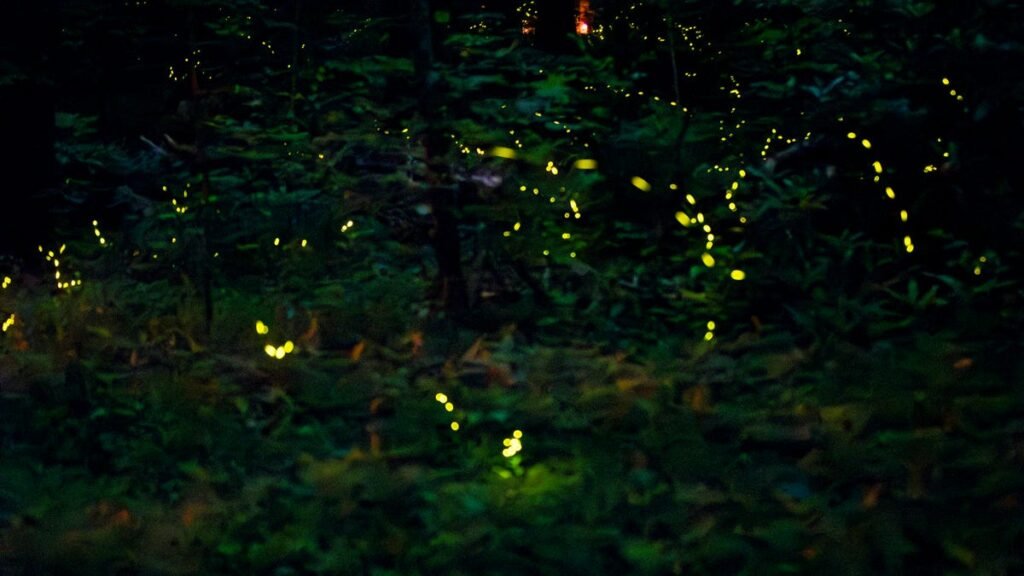The Enchanting Firefly Magic of Gatlinburg: Nature’s Light Show in the Smoky Mountains
There’s something truly magical about witnessing thousands of synchronous fireflies illuminating the darkness of the Great Smoky Mountains. As someone who has spent years exploring the hidden wonders of Gatlinburg, I can tell you that few natural phenomena compare to the mesmerizing light display these tiny creatures create each summer.
Recently in Gatlinburg, Tennessee, visitors were treated to an extraordinary spectacle – fireflies emerging “one by one and then all at once, swarming the underbrush and pooling in the hollows.” The way they blinked “crazily like fiber optic filaments in a planetarium” created a natural light show that no human technology could replicate.
Understanding the Synchronous Fireflies of the Smokies
The Great Smoky Mountains National Park is home to at least 19 species of fireflies, but the Photinus carolinus species steals the spotlight each year. These special fireflies are one of the few species in the world that can synchronize their flashing light patterns, creating a spectacular coordinated display that ripples through the forest like a “starling murmuration.”
I’ve been fortunate enough to witness this phenomenon multiple times over my years of writing about the Smokies, and each experience feels as magical as the first. The way they “ripple and wave along the forest floor” before suddenly “going dark all together” creates a rhythm that seems almost orchestrated.
When and Where to Experience the Firefly Magic
The synchronous firefly event typically occurs for about two weeks in late May to mid-June. The exact timing depends on temperature, moisture, and other environmental factors that scientists are still studying.
Elkmont Campground in the Great Smoky Mountains National Park is the most famous viewing area, but the fireflies can be spotted in various locations throughout Gatlinburg and the surrounding forests during peak season.
| Viewing Location | Best Time to Visit | Viewing Access |
|---|---|---|
| Elkmont Campground | Late May – Mid June | Lottery system for limited passes |
| Cades Cove | Early June | Public access with parking limitations |
| Private Cabin Areas | Late May – Mid June | For guests staying in mountain cabins |
Why This Natural Light Show Matters
Beyond the sheer beauty of watching these insects “blinking crazily like fiber optic filaments,” the synchronous firefly display represents something deeply important about our natural world. These fireflies are flashing in harmony as part of their mating ritual – a dance of light that has occurred in these mountains for thousands of years.
The preservation of dark skies and natural habitats in the Smokies allows this remarkable phenomenon to continue. Each year, the display serves as a reminder of why protecting these mountains matters so deeply to those of us who love this area.
Tips for Responsible Firefly Viewing
- Use red cellophane over flashlights to minimize disruption to the fireflies
- Stay on designated trails to protect the forest undergrowth where fireflies live
- Never capture fireflies in jars or containers
- Speak quietly and be respectful of other viewers
- Leave no trace of your visit to help preserve this natural wonder
The Science Behind the Synchronicity
Scientists believe the synchronized flashing helps the males and females of the species recognize each other. The males flash while flying, and the females respond with a flash from their perch near the ground. This communication helps them find mates in the darkness of the forest.
What’s most remarkable is how they achieve this synchronization without any central conductor. Each firefly adjusts its rhythm based on the flashing of its neighbors, creating what scientists call “spontaneous order” – a perfect example of how complex systems in nature can self-organize.
Beyond the Fireflies: Exploring Gatlinburg
While the synchronous fireflies might bring you to Gatlinburg, the charm of this mountain town will make you want to stay. From the stunning views along the Roaring Fork Motor Nature Trail to the rustic cabins nestled in the hills, Gatlinburg offers a perfect base for exploring the natural wonders of the Smokies.
After your evening with the fireflies, consider spending a day hiking to Rainbow Falls or exploring the historic buildings at Cades Cove. The mountains have stories to tell in daylight too.
Preserving the Magic for Future Generations
The continued existence of these spectacular light shows depends on our commitment to conservation. Light pollution, habitat destruction, and climate change all threaten the delicate ecosystems that support firefly populations.
By visiting respectfully and supporting conservation efforts in the Great Smoky Mountains National Park, we can help ensure that future generations will also experience the wonder of watching these insects “swarming the underbrush and pooling in the hollows, blinking crazily” in the summer darkness.
Planning Your Visit
If you’re hoping to witness this natural phenomenon, plan well in advance. The National Park Service typically announces viewing dates and lottery information in April. Even if you don’t secure a spot at Elkmont, there are many areas throughout Gatlinburg where you might catch glimpses of these remarkable insects.
Remember to bring your sense of wonder and patience – nature operates on its own schedule, and the best displays often require waiting until full darkness descends on the forest.
Experience the Magic Yourself
Have you ever witnessed the synchronous fireflies of Gatlinburg? The way they create patterns that ripple “almost like a starling murmuration” leaves an impression that stays with you long after the lights have gone dark. It’s one of those experiences that reminds us why the Great Smoky Mountains are not just protected – they’re treasured.
Whether you’re a long-time lover of the Smokies like me or planning your first visit, the firefly display offers a glimpse into the magic that makes these mountains so special. Come experience the wonder for yourself, and you’ll understand why those of us who write about this area never run out of reasons to return.

